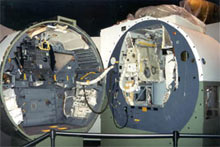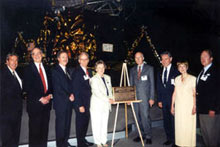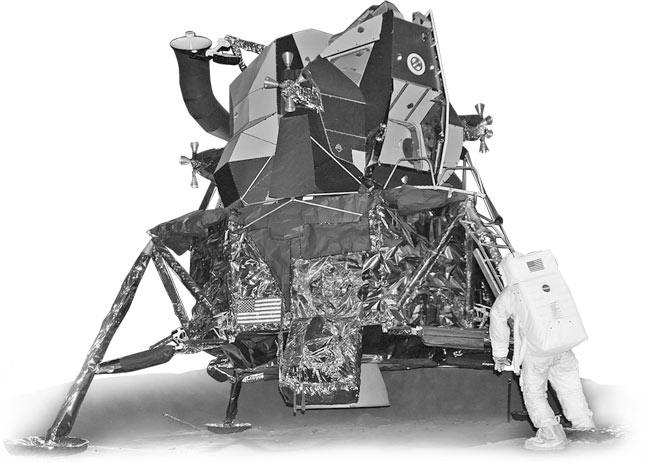#218 Apollo Lunar Module LM-13
1972
First piloted vehicle designed to operate solely in the vacuum of space
Image Caption Continued: Left to right: Harry Armen (ASME/Northrop Grumman), John R. Parker (ASME Past President), Philip A. Teel (Northrop Grumman), Tom Gwynne (museum), Joan Kelly (Thomas J. Kelly's wife), Joe Gavin (Grumman), Edward J. Smits (Nassau Heritage), Dixie Scovill (Newsday), Rudy Landwaard (ASME Region VP).
Two other unfired modules already are preserved in museum settings (No. 2 is at the Smithsonian Institution, and No. 15 is at Kennedy Space Center), but this one, No. 13, is made special by being near its birthplace at Northrop Grumman. Grumman's facility in Bethpage, New York, designed and produced the lunar modules, which would orbit the moon, attached to command and service modules.
The LM's module design was economical because each could be designed for specialized functions of exploration and re-entry operations. Thomas J. Kelley, who served as the engineering manager and eventually deputy program manager for the lunar module program, has recalled in the past, "We didn't know anything about space anymore than most people did at that time. But we did know a lot about producing reliable flying machines." Kelley's mechanical engineering and propulsion concepts and designs helped shape the plans for the Apollo missions.
Thirteen lunar modules were built and six landed on the moon. No. 13, which was to have flown on the canceled Apollo 18 flight, is on permanent loan from the Smithsonian Institution to the Cradle of Aviation Museum.
The last Apollo flight took place in December 1972, with Apollo 17. The Lunar Module is one of three components making up the Apollo spacecraft. The story of the Apollo program is told in other ASME landmarks as well. An Apollo command module, built by Rockwell and which flew as Apollo 14 in 1971, was designated an ASME landmark in 1992. The Saturn V rockets that launched the Apollo crafts were designated in 1980, at space centers in Alabama, Florida, and Texas.
For More Information
Cradle of Aviation Museum
Garden City, Long Island, NY
Useful Links
Cradle of Aviation Museum:
http://www.cradleofaviation.org
Ceremony Notes
19 April, 2002, plaque presented by Past President John R. Parker



